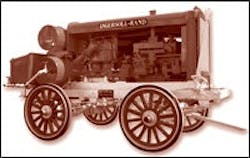Celebrating 100 Years of Ingersoll Rand
One of America's most successful industrial equipment companies was born when entrepreneurs Simon Ingersoll and Albert Rand joined forces in 1905 to form Ingersoll Rand. The company survived and prospered over the decades, evolving into the global enterprise known today as Ingersoll Rand Co., headquartered in Bermuda.
Through a number of well-known subsidiary companies, Ingersoll Rand today provides a diverse range of products including refrigeration equipment, golf cars, turbines, security locks, temperature controls as well as equipment for construction and agriculture. It employs approximately 40,000 people and achieves more than $10 billion in annual sales.
It all started in 1871 when Simon Ingersoll invented a steam-powered rock drill. Faster, lighter and more productive than its predecessors, the Ingersoll drill was the first to be mounted on a tripod. It revolutionized the drilling industry and the Ingersoll Rock Drill Co. was established, later becoming the Ingersoll-Sergeant Drill Co. of New York.
But Simon Ingersoll soon ran into stiff competition. In the 1870s the Rand Drill Co., headed by inventor Albert Rand introduced an air compressor to power drills produced by his company. After nearly three decades of friendly, but fierce, competition, and with both companies holding key drill and compressor patents, the leadership of both firms realized the benefits of joining forces. A few months of negotiations led to the historic merger on June 1, 1905, when the Ingersoll Rand Co. was established.
The new company consolidated its products and corporate structures, and grew into a powerful entity, rapidly exceeding the size of the two former firms. In 1910, Ingersoll Rand launched an electric-powered compressor that varied a drill's output by regulating air input. In addition to the rotary and percussion drills on which the company was founded, a wide range of air-powered tools were developed. In 1929, the Type 30 reciprocating compressor hit the market at the start of the Great Depression. But this compact and efficient model, built like a two-wheel hand cart, enjoyed instant success. It fueled profits and helped the company to survive at a time when orders for large equipment virtually disappeared.
In March 2005, Ingersoll Rand celebrated its Centennial during the Conexpo-Con/Agg show in Las Vegas. Two beautifully restored antique air compressors from the 1920s were on display.
You can read more about the evolution of construction equipment in Keith Haddock's illustrated book "The Earthmover Encyclopedia," available in most bookstores. Also, consider a membership in the Historical Construction Equipment Association, www.hcea.net .

